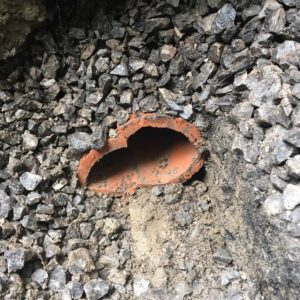Poured Concrete Foundation Repair
Knowing the age of your foundation
Generally speaking, there two types of poured foundations.
Firstly, there are homes built at the turn of the century where the foundation was formed with boards and the concrete was mixed and poured on site. Usually, using very low quality concrete with stones found on site thrown into the forms and concrete mix. Some mistakenly call this type of foundation rubble.
Just about every home in the Ottawa built before the 1940s would likely have this type of construction.
And secondly, the newer poured foundations, seen more in homes built after the 1930s, are still formed with planks and boards but the concrete mix was of a much higher quality. More modern forms and ties weren’t used until the 1960s.
Let’s address these two types of poured foundations separately and the different issues they have.
Turn of the Century Poured Foundations (1900-1940s)
These homes had little, none or completely washed away damp proofing. Damp proofing being the lowest form of foundation protection from water (other than none at all) does very little to protect against water and dampness entering the concrete. Other than the obvious issues with water damage to the inside of your basement and/or mould and mildew, a damp wall that freezes causes concrete damage. This freeze/thaw cycle can literally cause the concrete to turn to dust (spalling). The very poor quality of this turn of the century concrete makes this a very common problem.
It should be mentioned, that the lack of drain tile (weeping tile) makes things worse by not allowing water to drain away from the foundation.
Poured Foundations (1940 -)
With these poured foundations we still see damage due to freezing where the concrete turns to dust but it’s not as prevalent with the better quality concrete. The same water and dampness issues, with mould and mildew is still of great concern. Drainage tile (weeping tile) are almost always found but the old clay tile is usually packed with soil or clay and many times broken. Plastic drain pipe didn’t became the standard until the 1970’s but lacked a filter sock until the 1990’s. Therefore, the plastic pipes get clogged up as well.
Common Poured Concrete Foundations problems

Insufficient Waterproofing (Damp Proofed Only)
Damp proofing is a light coat of a tar that is sprayed on. Generally it’s a very light coating that offers very little protection from water penetration. The problem is compounded when the backfill material is clay which hold the water. The porous concrete draws the moisture in. If the basement is finished the moisture is trapped behind the walls and insulation which is where the mould will grow.
Air is your Friend
If you cannot afford to waterproof you should keep your concrete foundation walls exposed and have good air circulation.

Freeze / Thaw
This freeze thaw cycle can literally cause the concrete to turn to dust (spalling). The very poor quality of this turn of the century concrete makes this a very common problem.

Damaged Weeping Tile (or non-existing)
Very common in homes that are more than 40 years old but can happen in new homes as well.

Wall Cracks
The most common cause of basement water in homes is from leaking wall cracks. Concrete walls will crack due to the release of water during the curing process. Cracks will commonly be found near breaks in the wall (such as windows and beam pockets) or in the middle of long walls uninterrupted by turns in the wall. These cracks will not automatically leak but often do. Surface repairs with rigid products such as hydraulic cement or epoxy will often fail again within a couple of years. Proper crack repair requires that the cracks be fully filled with either epoxy resin or urethane foam.

Tie Holes
Tie holes are where the left over metal of the rods that were holding the concrete forms together during foundation construction. Ties are usually round or flat. Round ties can be a problem when used in colder conditions. As the forms are removed, the ends of the tie rods are broken off with a hammer. Because the concrete walls cure significantly slower in the winter months, striking the ties can loosen the bound with the concrete creating a wall of leaking ties.
Repair is simple and can be done by coating the surface of the hole with a two part epoxy or urethane paste or even hydraulic cement.

Honeycombs
Honeycombs (aka Dry Pour), are areas in the wall where the Portland cement has not been able to completely cover the aggregate. Some causes are the concrete remaining in the truck too long, concrete was not vibrated at pour or a second pour over a first.

Pipes
Service pipes like: gas, electrical, well and septic lines. Usually the space around these pipes are filled with Hydraulic cement which begins to cure in minutes so may only be pushed 2 to 3 inches into the wall.
Vibration in the pipe, along with other factors, will often break the seal of the cement. A common ineffective approach is to re apply the cement or to coat the area with a sealant. Coating the surface of the basement interior wall, typically, will not stop leaks.

About Our Work

Read Our Reviews
Request an Estimate
We take pride in providing top-notch service using proven products and techniques on every home we repair. We advise you to get 3 estimates, and to make sure that we're one of them. We'll explain all the work in a written quote before the start of any project.
